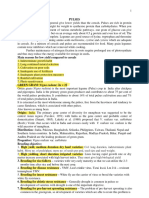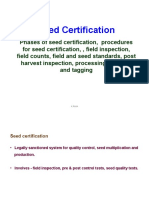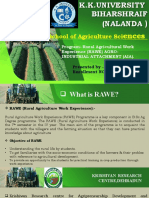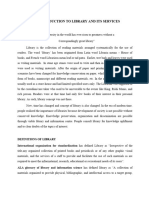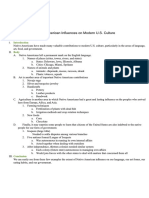0 ratings0% found this document useful (0 votes)
588 viewsAbhishek Kumar - Conventional & Modern Innovative Approaches For Development of Hybrids and Varieties For Yield of Pearl Millet
Abhishek Kumar - Conventional & Modern Innovative Approaches For Development of Hybrids and Varieties For Yield of Pearl Millet
Uploaded by
Abhishek KumarThis document discusses conventional and modern approaches for developing hybrids and varieties of pearl millet to increase yields. It describes pearl millet's importance as a crop in India and outlines conventional breeding techniques like plant introduction, mass selection, hybridization, and mutation breeding that have been used. It also mentions modern biotechnological methods and genetic engineering that could help shorten the time needed for variety/hybrid development compared to conventional methods. The document emphasizes the need for innovative modern approaches to overcome barriers to hybridization.
Copyright:
© All Rights Reserved
Available Formats
Download as PPTX, PDF, TXT or read online from Scribd
Abhishek Kumar - Conventional & Modern Innovative Approaches For Development of Hybrids and Varieties For Yield of Pearl Millet
Abhishek Kumar - Conventional & Modern Innovative Approaches For Development of Hybrids and Varieties For Yield of Pearl Millet
Uploaded by
Abhishek Kumar0 ratings0% found this document useful (0 votes)
588 views14 pagesThis document discusses conventional and modern approaches for developing hybrids and varieties of pearl millet to increase yields. It describes pearl millet's importance as a crop in India and outlines conventional breeding techniques like plant introduction, mass selection, hybridization, and mutation breeding that have been used. It also mentions modern biotechnological methods and genetic engineering that could help shorten the time needed for variety/hybrid development compared to conventional methods. The document emphasizes the need for innovative modern approaches to overcome barriers to hybridization.
Original Description:
Conventional And moderninnovative approaches for development
Original Title
17011044_Abhishek Kumar_Conventional & Modern innovative approaches for development of hybrids and varieties for yield of Pearl millet
Copyright
© © All Rights Reserved
Available Formats
PPTX, PDF, TXT or read online from Scribd
Share this document
Did you find this document useful?
Is this content inappropriate?
This document discusses conventional and modern approaches for developing hybrids and varieties of pearl millet to increase yields. It describes pearl millet's importance as a crop in India and outlines conventional breeding techniques like plant introduction, mass selection, hybridization, and mutation breeding that have been used. It also mentions modern biotechnological methods and genetic engineering that could help shorten the time needed for variety/hybrid development compared to conventional methods. The document emphasizes the need for innovative modern approaches to overcome barriers to hybridization.
Copyright:
© All Rights Reserved
Available Formats
Download as PPTX, PDF, TXT or read online from Scribd
Download as pptx, pdf, or txt
0 ratings0% found this document useful (0 votes)
588 views14 pagesAbhishek Kumar - Conventional & Modern Innovative Approaches For Development of Hybrids and Varieties For Yield of Pearl Millet
Abhishek Kumar - Conventional & Modern Innovative Approaches For Development of Hybrids and Varieties For Yield of Pearl Millet
Uploaded by
Abhishek KumarThis document discusses conventional and modern approaches for developing hybrids and varieties of pearl millet to increase yields. It describes pearl millet's importance as a crop in India and outlines conventional breeding techniques like plant introduction, mass selection, hybridization, and mutation breeding that have been used. It also mentions modern biotechnological methods and genetic engineering that could help shorten the time needed for variety/hybrid development compared to conventional methods. The document emphasizes the need for innovative modern approaches to overcome barriers to hybridization.
Copyright:
© All Rights Reserved
Available Formats
Download as PPTX, PDF, TXT or read online from Scribd
Download as pptx, pdf, or txt
You are on page 1of 14
DEPARTMENT OF PLANT BREEDING
TIRHUT COLLEGE OF AGRICULTURE, DHOLI
DR. RAJENDRA PRASAD CENTRAL AGRICULTURAL
UNIVERSITY, PUSA
Course: APG-301[Crop Improvement-1(Kharif Crop)]
Assignment Topic: Conventional & Modern innovative approaches for
development of hybrids and varieties for yield of Pearl millet.
Submitted to: Submitted By: Abhishek Kumar
Dr. S.K. Singh Roll No. 17011044
Batch: 2017-18(5th Semester)
Dr. A.K. Singh
Dr. M.K. Singh
Pearl Millet (Pennisetum glaucum)
■ Family- Poaceae, Chromosome no. 2n=14, Origin West Africa.
■ Pearl millet is a highly cross-pollinated species. Wind is supposed to be the major cross
pollinating agent.
■ It is a C4 plant having a very high photosynthetic efficiency and dry matter production
capacity.
■ It is also called Ragi.
■ It is usually grown under the most adverse agro-climatic conditions where other crops like
sorghum and maize fail to produce economic yields.
■ It has a remarkable ability to respond to favorable environments because of its short
developmental stages and capacity for high growth rate, thus making it an excellent crop for
short growing seasons under improved crop management.
■ Majority of crop area is in Asia (>10 million ha) and Africa (about 18 million ha).
TCA/2017-18/Abhishek Kumar 17011044
Pearl Millet for Indian Context
■ In India, pearl millet is the third most widely cultivated food crop after rice and wheat.
■ It is grown on 9 million ha with an average productivity of 1,000 kg ha−1.
■ The major pearl millet growing states are Rajasthan, Maharashtra, Gujarat, Uttar
Pradesh and Haryana which account for more than 90 % of pearl millet acreage in the
country.
■ Grown in three seasons as described below.
a. Kharif season (June–September) is most prevalent.
b. Summer season (February–May) in some parts of Gujrat, Rajasthan & U.P.
c. Rabi) season (November–February) at a small scale in MH &Gujarat.
TCA/2017-18/Abhishek Kumar 17011044
Pearl Millet importance
■ Pearl millet is primarily grown for food and dry fodder.
■ The grains are highly nutritious with high levels of metabolizable energy and protein,
have high densities of iron and zinc, and more balanced amino acid profile.
■ It is also an excellent forage crop because of its lower hydrocyanic acid content than
sorghum.
■ Its green fodder is rich in protein, calcium, phosphorous and other minerals with oxalic
acid within safe limits.
■ Significant portion of pearl millet grain is also used for non-food purposes such as
poultry feed, cattle feed and alcohol extraction.
TCA/2017-18/Abhishek Kumar 17011044
Pearl Millet Breeding
Conventional Breeding Procedures for Pearl Millet
Plant Introduction
Mass Selection
Hybridisation
Heterosis breeding
Mutation Breeding
Modern Breeding Procedures for Pearl Millet
Biotechnological methods
Genetic engineering
TCA/2017-18/Abhishek Kumar 17011044
Plant Introduction
■ Plant introduction is a process of introducing plants(a
genotype or a group of genotypes) from their own
environment to a new environment.
■ Introduction of hybrid bajra from Punjab & Tift 23 A
from USA
TCA/2017-18/Abhishek Kumar 17011044
Mass Selection
■ It is the oldest methods of crop improvement.
■ In it large number of plants of similar phenotype are selected and
their seeds are mixed together to constitute a new variety is called
mass selection.
■ For Pearl Millet Mass selection the earlier released variety Co5 is
result of mass selection. The variety Co6 is selection from Nigerian
accession MS 7625 selected for high tillering, long panicle, dense
seed setting and bold seeds along with downy mildew resistance.
TCA/2017-18/Abhishek Kumar 17011044
Hybridisation
■ Hybridization is the process of interbreeding between
individuals of different species (interspecific hybridization) or
genetically divergent individuals from the same species
(intraspecific hybridization).
■ Interspecific hybridisation in Pearl Millet
Pennisetum glaucum x P.purpureum Cumbu napier hybrids
TCA/2017-18/Abhishek Kumar 17011044
Heterosis breeding
■ In earlier days before the identification of male sterile lines utilising the protogynous
nature hybrids were released. The hybrids were produced by sowing both parents in the
ratio of 1:1.
■ After the discovery of cytoplasmic genic male sterile line Tift 23A by Burton in Tifton,
Georgia led to development of hybrids. Earlier hybrids of India viz., HB1, HB2 to HB5
were produced utilizing Tift 23 A. But due to susceptibility to downy mildew they went
out of cultivation. Even before the discovery of CGMS lines by Burton it was
discovered by Madhava Menon and his coworkers at Coimbatore. Unfortunately due to
failure of publishing it was not recognized.
■ To over come the problem of downy mildew male sterile lines L 111A and 732 A were
isolated and at present used in breeding programme.
■ There are number of CMS lines developed by private agencies like Nath seeds, Mahyco,
Mahendra.
TCA/2017-18/Abhishek Kumar 17011044
Mutation Breeding
■ The process of exposing seeds to chemicals or radiation in
order to generate mutants with desirable traits to be bred with
other cultivars.
■ At IARI Tift 23 A was gamma irradiated and 5071 A resistant
to downy mildew was evolved. With this the hybrid NHB 3
was evolved (5071 A x J 104).
TCA/2017-18/Abhishek Kumar 17011044
Biotechnological methods
&Genetic engineering
■ One of the approaches is the use of ‘Biotechnology’ through different cell
and tissue culture techniques and genetic engineering methods. Somatic
hybrid production by protoplast culture-fusion technique, use of different
molecular biological techniques and alien gene incorporation into the
genetic background of cultivated species thus become obvious.
■ Not much work has been done on transgenesis in other millets. This is
primarily because they have less economic value and are cultivated in
poor countries, where research and development are also poor. In the
present review we have attempted to provide available information on
millet tissue culture and genetic transformation.
TCA/2017-18/Abhishek Kumar 17011044
Need of Modern innovative approaches
for development of hybrids and varieties
■ In the conventional plant breeding programme, the
development of a new variety or hybrid takes about five to
twelve years, starting from inbred production and then
hybridization and selection of F1 hybrids. To overcome the
sexual barrier (pre-fertilisation and post-fertilisation), there is
the need of modern non-conventional breeding methods.
TCA/2017-18/Abhishek Kumar 17011044
References
■ Agrimoon.com
■ Reserchgate.net
■ Wikipedia.org
■ BAU Sabour notes
TCA/2017-18/Abhishek Kumar 17011044
Thanks…
TCA/2017-18/Abhishek Kumar 17011044
You might also like
- Agricola RatingsDocument16 pagesAgricola RatingsJanJanssenNo ratings yet
- Olericulture I PM XIDocument160 pagesOlericulture I PM XIYano100% (1)
- Soc 401 Assignment 1 SolutionDocument3 pagesSoc 401 Assignment 1 SolutionEDP SectionNo ratings yet
- Present Status and Scope of Post Harvest Technoogy in India: Scientist (Agril. Processing & Food Engineering)Document16 pagesPresent Status and Scope of Post Harvest Technoogy in India: Scientist (Agril. Processing & Food Engineering)bhagwatNo ratings yet
- Rawe Project Report NishaDocument30 pagesRawe Project Report NishaPrashant DubeyNo ratings yet
- Constraint / Problems in Rural Development:: 1. PovertyDocument3 pagesConstraint / Problems in Rural Development:: 1. Povertydivyanshu sharmaNo ratings yet
- RAWEDocument24 pagesRAWERasmi RanjanNo ratings yet
- Members of Inspection Team Designation Mobile No. Email IDDocument11 pagesMembers of Inspection Team Designation Mobile No. Email IDjhvjNo ratings yet
- "Rural Agriculture Work Experience": Submitted ToDocument67 pages"Rural Agriculture Work Experience": Submitted ToSai Teja100% (1)
- Final MSC Thesis Report Ibsa - 0 Chickpea 2Document84 pagesFinal MSC Thesis Report Ibsa - 0 Chickpea 2aakuma100% (4)
- New RaweDocument80 pagesNew RaweAkshita SharmaNo ratings yet
- GPB-243 Theory NotesDocument86 pagesGPB-243 Theory NotesRushikesh Kshirsagar100% (1)
- Tools For Hybrid Seed Production (RS)Document3 pagesTools For Hybrid Seed Production (RS)yudhvir100% (1)
- B.D Singh - Plant Breeding..Document659 pagesB.D Singh - Plant Breeding..znx5fdtkkjNo ratings yet
- Indian Minimum Seed Certification StandardsDocument605 pagesIndian Minimum Seed Certification Standardsmanojban100% (4)
- AEG Lecture - 3Document6 pagesAEG Lecture - 3maliniguru2003No ratings yet
- Greengram and Black GramDocument5 pagesGreengram and Black GramASHUTOSH MOHANTYNo ratings yet
- GPB 321 Crop Improvement Manual FinalDocument71 pagesGPB 321 Crop Improvement Manual FinalSultan AhmadNo ratings yet
- LINSEED / FLAX (Linum UsitatissimumDocument35 pagesLINSEED / FLAX (Linum UsitatissimumAnshul Sharma100% (1)
- Ibps Afo Syllabus PDFDocument3 pagesIbps Afo Syllabus PDFDurvas MadameNo ratings yet
- Lucerne (Alfalfa) Botanical Name: Medicago Sativa L. Family: Fabaceae (Alt. Leguminosae) Subfamily: Faboideae Tribe: TrifolieaeDocument5 pagesLucerne (Alfalfa) Botanical Name: Medicago Sativa L. Family: Fabaceae (Alt. Leguminosae) Subfamily: Faboideae Tribe: TrifolieaeGanpat Lal SharmaNo ratings yet
- Icar JRF Exam 2017 Horticulture Part 4 Horticulture Gyan PDFDocument11 pagesIcar JRF Exam 2017 Horticulture Part 4 Horticulture Gyan PDFPinky Sahu100% (1)
- Manual Cum Record Principles of Seed TechnologyDocument69 pagesManual Cum Record Principles of Seed TechnologyPasupathi T100% (1)
- Importance and Role of KVKDocument11 pagesImportance and Role of KVKAman kumar0% (1)
- Chapter 5Document4 pagesChapter 5Akash RajvanshiNo ratings yet
- Seed Production in Self Pollinated Crops - WheatDocument18 pagesSeed Production in Self Pollinated Crops - Wheatalemneh bayehNo ratings yet
- ASRB NET Fruit Science 2023Document17 pagesASRB NET Fruit Science 2023Zara Elzebath100% (1)
- Concept of Seed Quality and Seed Quality TestingDocument19 pagesConcept of Seed Quality and Seed Quality TestingKumari Rajani100% (2)
- Seed and Seed Technology: Introduction, Definition and ImportanceDocument42 pagesSeed and Seed Technology: Introduction, Definition and ImportanceMuhammad Nadeem AkramNo ratings yet
- Agriexam Guruji: Quiz Topic-Cropping Systems & PatternsDocument5 pagesAgriexam Guruji: Quiz Topic-Cropping Systems & PatternsDHUVADU JAGANATHAMNo ratings yet
- 2019-AFO Mock TestDocument9 pages2019-AFO Mock Testdeepak100% (2)
- Laboratory Manual: AGR207 Livestock and Poultry Management (For Private Circulation Only)Document59 pagesLaboratory Manual: AGR207 Livestock and Poultry Management (For Private Circulation Only)Ch Dheeraj RaoNo ratings yet
- Assignment On:: CitronellaDocument7 pagesAssignment On:: Citronellashalini shuklaNo ratings yet
- Topics To Be Covered AFO-2019Document5 pagesTopics To Be Covered AFO-2019deepak0% (1)
- Hort - 355 ManualDocument47 pagesHort - 355 ManualKaran NawaleNo ratings yet
- Agronomy of Field Crops-IIDocument114 pagesAgronomy of Field Crops-IIVishal ShuklaNo ratings yet
- 4th Sem All Model Answers (Agrounder)Document111 pages4th Sem All Model Answers (Agrounder)Words You Can FeelNo ratings yet
- Supply Chain Management in Fruits & VegetablesDocument33 pagesSupply Chain Management in Fruits & VegetablesRevanth KrNo ratings yet
- 26 Seed CertificationDocument40 pages26 Seed Certification100 SURIYANARAYANAN TNo ratings yet
- Problematic SoilsDocument45 pagesProblematic SoilsSimta Sharma100% (1)
- HRT-301-Production Technology For Fruits and Plantation CropsDocument69 pagesHRT-301-Production Technology For Fruits and Plantation CropsKeerthan Keerthan100% (2)
- RAWE RHWE Manual PDFDocument73 pagesRAWE RHWE Manual PDFGanpat Lal Sharma100% (1)
- Hitech HorticultureDocument7 pagesHitech HorticultureSuganthan SivaNo ratings yet
- Ele Hort 368 Full Printed Notes PDFDocument48 pagesEle Hort 368 Full Printed Notes PDFrushikesh KanireNo ratings yet
- Gholam Ali SynopsisDocument14 pagesGholam Ali SynopsisGanpat Lal SharmaNo ratings yet
- 7.TOMATO PPT - 0Document22 pages7.TOMATO PPT - 0Senthil MuruganNo ratings yet
- Kitchen Gardening PresentationDocument34 pagesKitchen Gardening PresentationMuhammad Mushtaq100% (3)
- MCQ 5Document7 pagesMCQ 5Akhand Pratap Singh50% (2)
- Determination of Drying Rate of Agricultural Products in A Green HouseDocument12 pagesDetermination of Drying Rate of Agricultural Products in A Green HouseAbhijeet SaratheNo ratings yet
- "Commercial Horticulture": Report On Experiential Learning Programme OnDocument18 pages"Commercial Horticulture": Report On Experiential Learning Programme OnMIT RAV33% (3)
- History of Organic FarmingDocument9 pagesHistory of Organic FarmingSanchita KulshresthaNo ratings yet
- Lec.2 Seed Quality, Deterioration of Crop Var, Genetic Purity Maintanence in Seed ProductionDocument37 pagesLec.2 Seed Quality, Deterioration of Crop Var, Genetic Purity Maintanence in Seed ProductionArun100% (2)
- 61 Post Harvest Management and Value Addition of Horticultural Crops-SignedDocument51 pages61 Post Harvest Management and Value Addition of Horticultural Crops-SignedNaveenNo ratings yet
- Mini Soil Lab: Soil Testing Kit and Fertilizer Recommendation Meter Pusa STFR MeterDocument3 pagesMini Soil Lab: Soil Testing Kit and Fertilizer Recommendation Meter Pusa STFR MeterSridhar KrishnamurthiNo ratings yet
- NishaDocument23 pagesNishaBhumihar BoyNo ratings yet
- Sudhir Debbarma RAWE ProjectDocument59 pagesSudhir Debbarma RAWE ProjectSamuel Davis100% (1)
- Vegetable Science MCQDocument1 pageVegetable Science MCQNitalPatel100% (2)
- PGS 501 LIS Class NotesDocument27 pagesPGS 501 LIS Class Notesphdecon2023No ratings yet
- Practical: Syllabus SST 321Document104 pagesPractical: Syllabus SST 321Senthamil ArasanNo ratings yet
- The Pearl Millet - BAJRADocument17 pagesThe Pearl Millet - BAJRADnyanu KordiyaNo ratings yet
- Native American in Uences On Modern U.S. CultureDocument1 pageNative American in Uences On Modern U.S. Culturequdratullah ehsanNo ratings yet
- Urban Consumers' Attitudes Towards Locally Grown ProduceDocument7 pagesUrban Consumers' Attitudes Towards Locally Grown ProduceRosa MartinezNo ratings yet
- Karat 9u12 enDocument16 pagesKarat 9u12 enKamil KováčNo ratings yet
- Metal Mining IDocument59 pagesMetal Mining IANSHUL YADAVNo ratings yet
- Dr. V. V. SADAMATE. Advisor of The Planning Commission of India. Indian Government.Document15 pagesDr. V. V. SADAMATE. Advisor of The Planning Commission of India. Indian Government.ffwconferenceNo ratings yet
- Contract FarmingDocument16 pagesContract FarmingNivedhaNo ratings yet
- Field CropsDocument37 pagesField CropsMohaajanan AliNo ratings yet
- Growth and Yield Perpormance of Pechay FinalDocument25 pagesGrowth and Yield Perpormance of Pechay FinalJaimeh Annabelle100% (2)
- Organic Agriculture RPLDocument7 pagesOrganic Agriculture RPLSUPRIYO BANERJEENo ratings yet
- Case Study - MineSched at SebukuDocument27 pagesCase Study - MineSched at SebukuBlank Kusuma100% (1)
- Agrome IQ International SDN BHD Company ProfileDocument4 pagesAgrome IQ International SDN BHD Company ProfileSolusi KomputerNo ratings yet
- Mandiri 1Document2 pagesMandiri 12210312099No ratings yet
- SAGCOT Brochure Poultry Strategic ApproachDocument2 pagesSAGCOT Brochure Poultry Strategic ApproachAndrew Justin MsunguNo ratings yet
- AGRICUTULTUREDocument6 pagesAGRICUTULTUREhussain korirNo ratings yet
- Mines in IndiaDocument2 pagesMines in Indiadharan511No ratings yet
- HEIRS OF AUGUSTO SALAS Vs Marciano CabungcalDocument2 pagesHEIRS OF AUGUSTO SALAS Vs Marciano CabungcalPaul Joshua Suba100% (1)
- Size and Scope of The Livestock IndustryDocument2 pagesSize and Scope of The Livestock IndustryVishal PhirkeNo ratings yet
- Erosion EssayDocument3 pagesErosion EssayNicky LewisNo ratings yet
- Crop Diversification in ASEAN CountriesDocument22 pagesCrop Diversification in ASEAN CountriesClara Joan JoachimNo ratings yet
- Flotation Plant Optimisation - Book ReviewDocument1 pageFlotation Plant Optimisation - Book ReviewcarloscjunoNo ratings yet
- Glitnir Seafood Industry Report - Tuna BDocument62 pagesGlitnir Seafood Industry Report - Tuna BAnkur SrivastavNo ratings yet
- Semesterwise List of Courses of B. Sc. (Hort.)Document19 pagesSemesterwise List of Courses of B. Sc. (Hort.)rupesh jadhavNo ratings yet
- AFA 7 Performance Task.Document4 pagesAFA 7 Performance Task.jaypen palomataNo ratings yet
- Perencanaan Reklamasi Di Timbunan Mahayung PT - Bukit Asam (Persero) TBK, Tanjung Enim, Sumatera SelatanDocument16 pagesPerencanaan Reklamasi Di Timbunan Mahayung PT - Bukit Asam (Persero) TBK, Tanjung Enim, Sumatera SelatanAlex Simon NababanNo ratings yet
- Tume Katalogi 2022 ENnettiDocument17 pagesTume Katalogi 2022 ENnettiService AgroMONDONo ratings yet
- AaaDocument2 pagesAaagrae16No ratings yet
- Session Plan - Produce Organic VegetableDocument14 pagesSession Plan - Produce Organic VegetableMerly Salvador100% (2)
- Water-A Precious Resource Worksheet 9 PDFDocument2 pagesWater-A Precious Resource Worksheet 9 PDFParul ShahNo ratings yet
- Blue Revolution FinalDocument10 pagesBlue Revolution FinalRamkrishna PalNo ratings yet

















